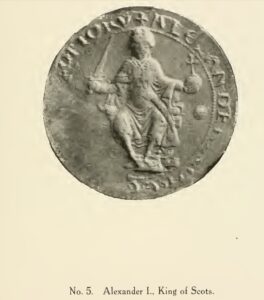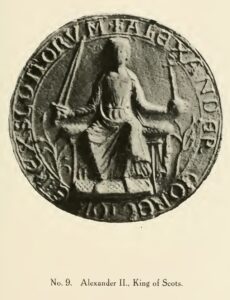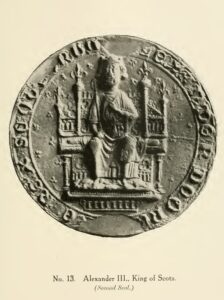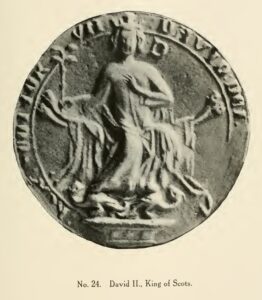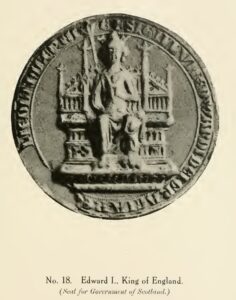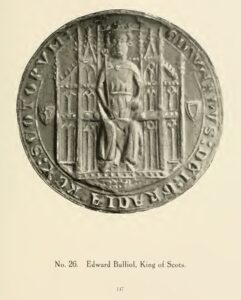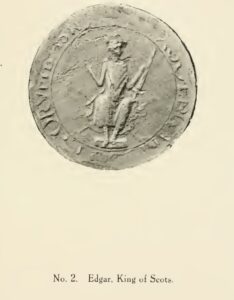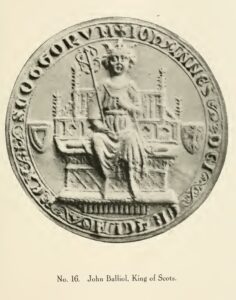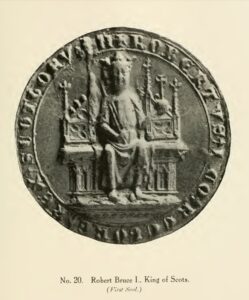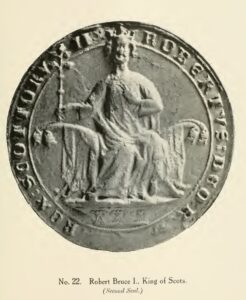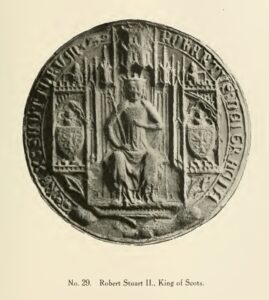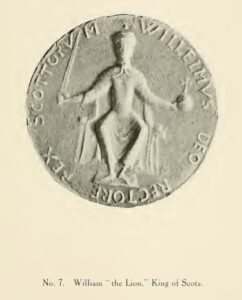The Stone of Scone – historical mythmaking at its best
Prior to the coronation of King Charles, Historic Environment Scotland carried out a digital scan of the Stone of Scone, the 3D image produced can be seen here if you fancy taking a look. It was then transported down to London, and has since returned to Edinburgh Castle.
The Stone is a block of sandstone that has traditionally been placed under the throne of the monarch at their coronation in Westminster, and is one of the most potent symbols of the nation of Scotland. As such, placing it under the throne of a monarch crowned in England is perceived by many to be symbolic of the oppression of Scotland by England. It is also the subject of a number of conspiracy theories which I hope to place in context.
One of those relates to the fact that the Stone is a lump of sandstone, appearing entirely consistent with quarries local to Scone. In 1998, a geological survey team assessed the stone and confirmed that to be the case, producing a resurgence in the production of theories relating to a “true” Stone of Scone having been hidden away prior to the arrival of King Edward I and his army at Scone, and the removal of the Stone to England. The question is, why did all this come about?
To understand this, we have to cast our minds back a long time. The following two annals are taken from the “Chronica gentis Scotorum,” written in the reigns of King David Bruce, and King Robert Stewart – David II and Robert II. Much of Scotland’s written heritage had been destroyed or forcibly taken south to England by this time, and although the Chronicle is assigned to John of Fordun, he may not have been the original author, and some at least of the account appears to date to the thirteenth century, perhaps an eyewitness account.
“XLVII – Alexander, son of the aforesaid King Alexander, a boy of eight years of age, came to Scone on the following Tuesday, the 13th of July, with a number of earls, barons, and knights. There were, likewise, there, the venerable fathers, David of Bernham, bishop of Saint Andrews, and Galfrid, bishop of Dunkeld, a man in great favour with both clergy and people, zealous in temporal and spiritual things, who endeared himself with both great and poor, but was a terror to evil-doers. The abbot of the monastery of Scone itself was also there. But lo! as soon as they were gathered together, there arose a dispute among the nobles. For some of them would have made not a king, but a knight, on that day, saying that it was an Egyptian day. Now this was said not because of the Egyptian day, but because the lord Alan Dorwart [sic], then justiciary of the whole of Scotland, wished to gird Alexander with the sword of knighthood on that day. While they were arguing, the lord Walter Comyn. Earl of Menteith, a man of foresight and shrewdness in counsel, answered and said that he had seen a king consecrated who was not yet a knight, and had many a time heard of kings being consecrated who were not knights; and he went on to say that a country without a king was, beyond a doubt, like a ship amid the waves of the sea, without rower or steersman. For he had always loved King Alexander, of pious memory, now deceased — and this boy also for his father’s sake. So he moved that this boy be raised to the throne as quickly as possible, — for it is always hurtful to put off what may be done at once; and, by his advice, the said bishops and abbot, as well as the nobles, and the whole clergy and people, with one voice, gave their consent and assent to his being set up as king.
XLVIII – And it came to pass that when this same earl, Walter Comyn, and all the clergy, heard this, they joined unto them some earls — namely, the lord Malcolm Earl of Fife, and the lord Malise, Earl of Stratherne — and a great many other nobles, and led Alexander, soon to be their king, up to the cross which stands in the graveyard, at the east end of the church. There they set him on the royal throne, which was decked with silken cloths inwoven with gold; and the bishop of Saint Andrews, assisted by the rest, consecrated him king, as was meet. So the king sat down upon the royal throne — that is, the stone — while the earls and other nobles, on bended knee, strewed their garments under his feet, before the stone. Now, this stone is reverently kept in that same monastery, for the consecration of the kings of Albania; and no king was ever wont to reign in Scotland, unless he had first, on receiving the name of king, sat upon this stone at Scone, which, by the kings of old, had been appointed the capital of Albania. But lo! when all was over, a highland Scot suddenly fell on his knees before the throne, and, bowing his head, hailed the king in his mother tongue, saying these words in Scottish…” – after which the text follows a somewhat unreliable genealogy leading back to Scota, daughter of the Pharaoh of Egypt.
Despite all assertions to the contrary, this is the earliest written account mentioning any coronation stone, and it describes the coronation of King Alexander III in 1249. Alexander was the last monarch of the so-called “Canmore” dynasty, those kings descended from King Malcolm III, who ruled Scotland from 1058 to 1093. After his death in battle at Alnwick alongside his designated heir Edward, a war of succession was fought amongst his other sons from two marriages, eventually resolved by the intervention of King William II Rufus of England in support of Edgar, who ruled from 1097 to 1107, although his authority was far from universal. Edgar was followed by his younger brothers Alexander I (1107-1124) and David I (1124-1153), and David by his grandsons Malcolm IV (1153-1165) and William (1165-1214). William was followed by his son Alexander II (1214-1249), who died on the island of Kerrera, leaving his eight year old son to succeed him as Alexander III.
This orderly sequence of succession disguises ongoing internecine conflict between various descendants of Malcolm III. Descendants of his first marriage, the MacWilliams, disputed the succession of Malcolm IV, William, and Alexander II. Descendants of the Moray dynasty, “removed” by Malcolm III disputed the succession of David I, as did Malcolm, the son of Alexander I. Throughout, large parts of what we now consider to be Scotland were not under the control of the kings – particularly in the north, west, and south. And although Alexander II had been married to Joan Plantagenet until 1238, Alexander III was a son of Marie de Coucy, meaning there were competing claims over who should “guide” the young king.
This did not only concern the English and French. Within Scotland there were two factions competing for authority and power. Their leading members were Walter Comyn of Badenoch and jure uxoris Earl of Menteith, and Alan Durward, claiming comital titles in Mar and Atholl. In the accounts given above, a diplomatic gloss is placed over this rivalry and how it impacted the coronation. Yet what is clear is that the rivalry impacted upon the ceremonial aspects of the inauguration, and that it required the intervention of the Bishop of St Andrews. The mention of the stone is almost in passing – more emphasis is placed upon the enthronement.
Whilst the “Fordun” account of the coronation of Alexander III suggests that the boy king was set upon a “royal seat” in front of a cross in the graveyard at Scone, the accounts of Wyntoun and Bower are more complex, the process of acclamation and the knighting the king being given nearly as much prominence as the coronation itself. In 1249, when King Alexander was inaugurated as king of Scots, he may have been the first to be crowned formally, and whilst there was undoubtedly a tradition about being acclaimed outside, the nature of that is unclear, and the whole ceremony of inauguration was still being developed – the anointing of the monarch with holy oil was not yet authorised by the Pope, for example. Much 14th century procedure seems to have been retrospectively assigned to a 1249 event which could have been somewhat rushed and fractious.
Dauvit Broun has meticulously analysed the texts of “Fordun” and concluded that part of the text was in fact composed in the lifetime of Alexander III, including two references to the “royal seat” which contained a piece of stone. There is no evidence whatsoever that anything other than the lump of Perthshire sandstone was used – and no direct evidence that mentions it prior to 1249.
How, then, had a tradition of coronation taking place outside, come to be, and what might it have entailed? How did a piece of sandstone come to hold a place of sufficient importance to be mentioned in this account?
Scone had been used as an inauguration site since perhaps the 9th century, after the collapse of the two main Pictish kingdoms at the hands of the Norse Vikings. My personal feeling is that Constantine II, who reigned from 903 until his abdication in 943, is likely to have played a big part in this. He was a sponsor of the monastic Culdee communities, and is believed to have overseen an amalgamation of the Gaelic west with the Pictish east. It was in his reign that the new nation was first called Scotland.
Scone Abbey is believed to have been a Culdee establishment, and an annal of 906 records that “King Constantine and Bishop Cellach met at the Hill of Belief near the royal city of Scone and pledged themselves that the laws and disciplines of the faith, and the laws of churches and gospels, should be kept pariter cum Scottis”. Such a pledge implies church support for Constantine as king of all Scotland – a suitable time for the expansion of the site, which lay in the centre of his kingdom. It was also a suitable time for the expansion of ceremony – perhaps incorporating the use of a symbolic stone. This may have already seen use as a cult item, perhaps having come from the Roman fort at Inveralmond (retrospectively named Bertha), the Roman Tay Bridge or the Severan fortress at Carpow near Abernethy. (Another cult site, not far from where I believe the Battle of Mons Graupius could have been fought). All factors that could give the stone more “sanctity” than we might believe today. Constantine himself shared his name with the Roman Emperor who made the Empire Christian, after all!
The following is a screenshot of the Scone area showing the Roman fort at Inveralmond as the red ring to left, the Tay Bridge location as the adjacent blue line, and the Scone complex as the red ring to right. For scale, bear in mind that it is less than a mile from the eastern end of the bridge to the Moothill at Scone.
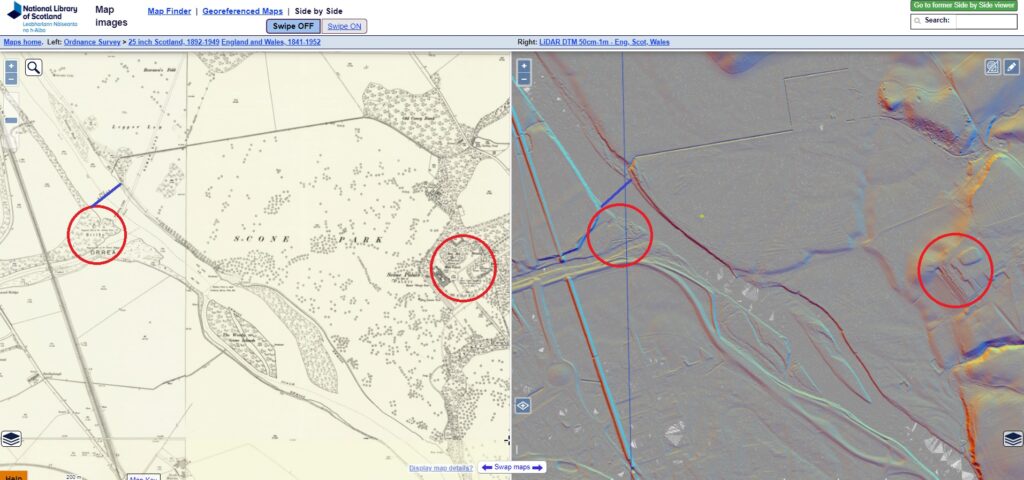
The inauguration of a monarch outside enabled public acclamation, and a key part of this was played by emphasising the antiquity of the monarch’s lineage – in the case noted above involving a very public accounting of all the kings that had gone before, historical and mythical. Part of this ceremonial antiquity was the location, used for time immemorial for king-making. Another part was the use of ancient symbols. A sceptre represented authority, sometimes replacing a sword. In many cultures of northern Europe, a cult-stone was then used, symbolically elevating the monarch above those around him – and often this was placed upon a mound, further elevating him. In some cases the stone was then incorporated into a kind of chair. One peculiar feature which appears on occasion is the use of shoes, by casting them over the head of the monarch and placing them on his feet.
In the case of Constantine II, and the proposed establishment of a more complex ceremony, we might also consider the Footprint Stone of Dunadd, often suggested to have had a ceremonial role in crowning the kings of Gaelic Dal Riata, with its footprint carved into the stone. Perhaps we might consider a shoe-wearing ceremony there at least! At the very least we should anticipate that the establishment of a new type of monarchy in association with the Church, would have required considerably more symbolism than before. Perhaps it is at this point that the Moot Hill of Scone started to be used, a feature about two metres high today. Its origin is unknown, despite geophysical survey and excavation. What has been confirmed, however, is that the Abbey Church occupied the location between the graveyard and the later palace, in the vicinity of the marker indicating stone coffins. Rereading the account of the 1249 coronation, the location of “the cross which stands in the graveyard, at the east end of the church” is clearly NOT on the Moothill.
The following is a screenshot of the Scone complex today from the maps section of the National Library of Scotland website, which strips back the vegetation with LIDAR.
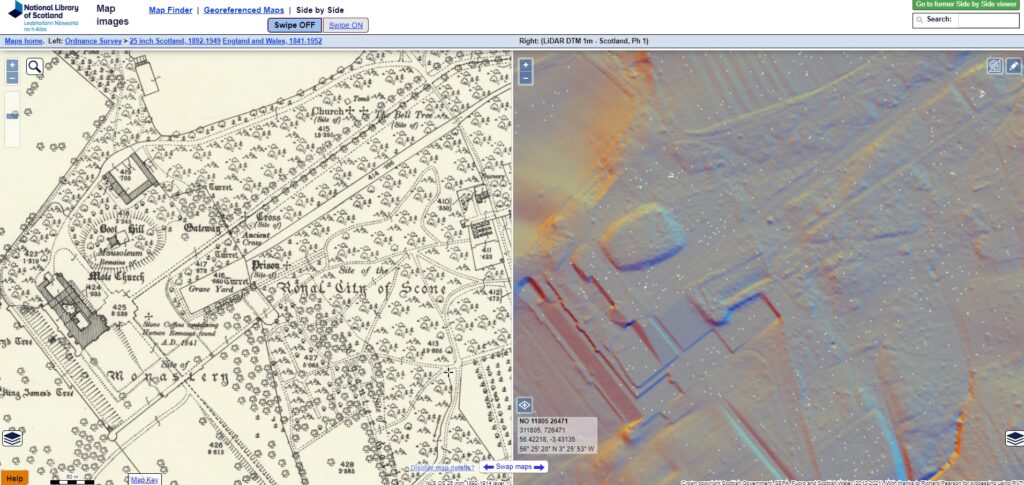
The seals of the kings of Scots are an indication as to how they wished to be perceived, and an examination of the side of the seals showing the kings sat upon their thrones is particularly interesting to consider. That of King Edgar shows him with a crown on his head, a sceptre in his left hand and a sword in his right. That of Alexander I shows a crown, sword, and an orb, and that of David is similar as far as it survives. No impression of the seal of Malcolm IV survives, but William’s shows a crown like Alexander’s, a sword and an orb. The seal of Alexander II has crown, sword, and orb. That of Alexander III is different, showing a sceptre, but no sword or orb. Images of these seals can be seen at the bottom of this blog.
What is interesting to consider with these seals is that in all cases the king is seated on a throne – and the depiction of that throne changes markedly. For Edgar it is a stool or chair, with the feet ending in claws – his feet rest on a dais of sorts. For Alexander I, the throne is cushioned, appears as square, and his feet rest on a rectangular dais. For William, his throne is again cushioned, but the sides are showing sloping towards the top. It is upon a plinth showing a crook-like finial, and again his feet rest upon a dais. For Alexander II, the throne is cushioned, the cover of the cushion diapered, and an arcade panel is shown on the front of the throne. The rectangular dais is also diapered – and a tree is depicted at each extremity of the throne. The throne of Alexander III is the most elaborately depicted, showing much carving . The back, sides and front are all shown with arcading, trefoils and quatrefoils, and fleur-de-lis depicted. His feet are on a dais covered with a cushion, the dais resting upon an arcaded block of sorts.
Of course, the more recent seal impressions show better preservation if for no other reason than more documents survive with their impressions upon. That of Edgar barely shows the throne at all, but his posture is reminiscent of Roman emperors, one foot advanced before another, and it is possible his throne was a curule chair of sorts. The thrones of Edgar, Alexander I and William are not depicted rising as high as the king’s shoulders – but the quality of impression may hide a back to the throne. That of Alexander II is unequivocal – the throne has no back, and it is clear here at least that whilst the arms of the chair and the back are cushioned, there is no suggestion that the king sat upon a cushion. The seal of Alexander III clearly shows a throne of much different scope, with a clearly defined and depicted back – and much more elaborate in style.
Exactly where the Stone would have fitted with the various thrones is unclear. However there are only two positions that it could practically fit. It measures 66cm wide, 42 cm deep, and 27cm tall. It could have been placed beneath the king’s feet – or else under the throne – potentially forming the seat for the king to sit directly upon. The relative dimensions of the throne depicted upon the seal of Alexander III implies that the Stone did not sit under the feet of the king, and the cushioned arms of the throne suggest that the Stone itself would have most likely been sat upon directly, although the rectangular recess carved in the stone could support the idea of padding.
When King Edward I of England deposed King John Balliol in 1296, he then appropriated the regalia of the Scottish kings. The tribunal, sceptre and crown of the Kings of Scotland were offered as a gift to St Edward the Confessor in Westminster Abbey the following year. Whilst the tale of the monks of Scone sneakily hiding the “true” Stone and presenting the English king with a lump of sandstone is attractive, there is nothing to sustain this story. Indeed, the protests made by the Guardians of Scotland to the Pope in 1301 that King Edward had stolen the sedile regium (the royal seat) are evidence to the contrary, that they fully believed the Stone was in England. Edward himself commissioned a new throne to allow the Stone to be placed beneath it. Having been present at John Balliol’s coronation, it is unlikely he would have taken anything south save the real stone.
Nevertheless, Thomas de Balmerino, Abbot of Scone, was one of many men targeted by King Edward. Having done homage to the king at Perth on 24th July 1291, and again in 1296, the abbey was still sacked by the English army on 17th August 1298 after the Battle of Falkirk. Abbot Thomas was present at the coronation of Robert Bruce in 1306, for which he was imprisoned and sent to England in chains, after which King Edward applied to the pope to sanction the translation of the abbey from its position “in the middle of a perverse people”. Presumably he had intended to then utilise the site for his own purposes, as he had previously done in Wales at Aberconwy and Llanfaes, appropriating important royal cult centres in order to superimpose his own rule, leaving no trace of the earlier site. The Pope did not grant this petition.
Robert Bruce, then, and all the kings of Scots after him, were almost certainly not crowned atop the Stone of Scone. Bruce’s coronation was undoubtedly a rushed affair, carried out in the aftermath of his sacrilegious murder of John Comyn on the altar at Dumfries Greyfriars, and although the Abbot of Scone was present, along with three bishops (Glasgow, Moray, St Andrews) and three earls (Atholl, Lennox, Mar), they hurriedly reconvened afterwards for a second coronation due to the late arrival of Isabella MacDuff, since it had been traditional for the earls of Fife to place the crown on the king’s head. The crown and sceptre used at King Alexander’s coronation (and King John’s, although doubtless nobody mentioned it!) were also now in Westminster, so what Bruce had available to him was very limited.
The troubled reign of David Bruce, in which he faced challenges to his rule in the name of Edward Balliol, and of Edward III himself, is one in which a new logic can be said to have begun. Edward Balliol was in fact crowned at Scone on 24th September 1332; it is not stated that any of the Scottish regalia from Westminster was used. However one of the seals of Robert Bruce, and that of David Bruce show a very different throne to that shown on the seal of Edward Balliol – which is the same as that shown on the seal of Alexander III. They have no backs, and none of the elaborate carving. Balliol’s also shows the sword and orb, like earlier kings, whereas the Bruce kings have a foliated sceptre. The implication is that Edward Balliol – like his father – could have been crowned on the Stone of Scone. (I think it likely that the other seal of Bruce was copied from that of his predecessor).
When David II died in 1371, his successor was his uncle, Robert Stewart. David had tried very hard to disinherit Robert, but his efforts were in vain. It now being towards the end of the reign of the aggressive Edward III of England, Stewart had become the leader of a firmly anti-English party within Scotland, politically opposed to the more pro-English party of David II – who had at one point negotiated that one of the sons of John of Gaunt would succeed him rather than the hated Stewart! As such, there was a renewed effort to rewrite Scottish history in a way that would promote the interests and actions of the house of Stewart, and denigrate or at the very least ignore all others where possible.
Thus it was that an aggressively independent Scottish national identity was being developed, and it is in light of this that we must see works such as the “Wallace” of Blind Hary, and the Scotichronicon of Walter Bower. They are a conscious effort to cast Scotland in the light of a nation-state entirely separate to England, and we see that all things English to be denigrated – or at worst vilified. Under the Stewarts, the somewhat equivocal but pragmatic career of Robert Bruce was recast as that of a hero-king. Wallace, a minor landowner and guerilla leader who asserted a bloody dominance over Scotland was similarly recast as a hero (he was perhaps a landholder under James Stewart), the role of the Douglas family, at this point unswervingly loyal to Robert Stewart, emphasised in the person of James Douglas, who died carrying Bruce’s heart into battle in Spain on a crusade. Other characters outright invented as a supporting cast, whilst the pro-Balliol (and therefore not pro-Bruce) Andrew Murray and the powerful Comyn clan who had been the most consistently opposed to English rule, faded from view altogether or were recast as traitors.
There were existing foundation-myths associating the kings of Scots with Egypt, but these, along with the association of the kings of Scots with Dal Riata are products almost entirely of the twelfth and thirteenth centuries, when King William was attempting to write his dynastic rivals out of any legitimate claim to his throne. This was appropriated by Bruce himself and his political advisors in order to assert their narrative against that of King Edward of England, and of course was useful to the Stewarts. However, the writings of the late 14th and early 15th centuries do have a very definite, and very clear, Stewart subtext, which is very important to consider.
The ceremony described by “Fordun” and others highlights the names of several nobles. Durward, earl of Atholl, and Comyn, earl (kind of) of Menteith. MacDuff, earl of Fife, and Malise, earl of Strathearn. In the reign of Robert II, the earl of Menteith, described as “a man of foresight and shrewdness in counsel” was Robert Stewart, the second son of the king. Menteith also held the title earl of Fife. Strathearn and Atholl had both been held by King Robert II prior to his coronation, but passed to his sons David and John. Therefore, all four nobles mentioned by “Fordun” as intimately involved in the coronation of Alexander III were royal Stewarts. The factions of Menteith and Atholl can be seen echoed in the factions led by John Stewart, who was appointed lieutenant to rule on behalf of his father in 1384 and his brother Robert, who displaced him in 1388. When King Robert II died in 1390, it was Fife who ruled, not giving his brother John any authority to rule until 1393.
Perhaps we should see in “Fordun” an appeal for wisdom and moderation between the sons of King Robert II, or the defeat of Durward of Atholl reflecting merely the success of Robert of Fife in sidelining his brother John. A potential side story to this might be the link between Comyn of Menteith and Comyn of Buchan – Buchan was held by the third son of Robert II, Alexander, better known as the Wolf of Badenoch. At the very least we can see sufficient parallels to consider that the whole story of the coronation described by “Fordun” is a piece of commentary about contemporary politics as much as it is an account of the coronation of Alexander III 150 years earlier.
For the best part of two hundred years at least, there were no suggestions that the sandstone beneath the throne in Westminster was anything other than the stone that had laid beneath the throne of Alexander III. However, at that time, a new piece of mythmaking and rewriting of history was taking place. The time of Shakespeare, and the time in which it became clear King James VI of Scotland would succeed Queen Elizabeth I as monarch of England. However, it was not until the nineteenth century that these suggestions started to bear much fruit. The Stewart dynasty had fallen again to infighting after the forced abdication of King James VII and II, and the rise of the Jacobite movement. It was in sympathy with this, I believe, that arguments started to be circulated about who was “rightfully” king of England and Scotland – Queen Mary and King William of Orange, or the abdicated King James, his son James Francis (the Old Pretender) and his son Charles Edward (the Young Pretender, aka Bonnie Prince Charlie).
In the end, the repeated defeat of the Jacobite faction in diplomacy and war led to the suppression of much that is now seen as Scottish culture, including bearing of arms, speaking Gaelic, wearing “Highland clothing”, piping and more. Fifty years later, Sir Walter Scott was producing much popular fiction about Scotland, and did much to rehabilitate Scotland in the eyes of court. In 1817, he was granted permission to search for the Honours of Scotland, hidden away since 1660 in Edinburgh Castle, and they were rediscovered in storage there in February 1818. The rediscovery combined with Scott’s own efforts to bring King George IV to Scotland in 1822, where the king dressed in tartan, popularising Scotland again in polite society.
This date is important when it comes to considering the Stone of Scone and the idea that it might not be the “true” stone. In January 1819, a letter was sent to the Morning Chronicle in London which is quoted in full on Wikipedia describing excavations carried out in November 1818 at Dunsinane – the location of an early medieval fort, its destruction carbon-dated to well before the age of MacBeth, who preceded Malcolm III “Canmore” as king of Scots. The same MacBeth who was used by Shakespeare to tell an entirely unhistorical story of treachery and usurpation.
This letter describes an impromptu excavation caused by the collapse of a piece of ground into a vaulted chamber about “six feet long and four wide” which was then excavated. During this, a large stone was discovered, “pronounced to be of the meteoric or semi-metallic kind” and estimated to weigh about 230kg. Alongside were two metallic discs, believed to be bronze, upon which were carvings translated to refer to angels and Bethel – clearly inferring that the buried stone was to be identified as Jacob’s Pillow – the Stone of Destiny. A rough calculation reveals that a semi-metallic meteoric stone weighing 230 kg would be about 33,000 cubic centimetres. The Stone of Scone by comparison is about 75,000, making this meteoric stone less than half the size. It should be noted that there is no mention of this stone being carved at all.
In the 1859 “Proceedings of the Society of Antiquities of Scotland” an account is made by T A Wise of his examinations of the excavations carried out by William Nairne at Dunsinane. This account describes the excavations of James Playfair c1799, and in “the previous year” in which four chambers were discovered in which were three burials. Wise notes dimensions far in excess of what the Chronicle letter states, but also notes the following – “after the wall had been raised 2 or 3 feet above the stone flooring of the chamber, the stones overlapped each other as the building advanced upwards, so as to form a roof, which was completed by a large flat stone placed over the top, the rude substitute for an arch.” This corbelling is not unusual for the Bronze Age, and it seems probable that the stone discovered was a cap stone of this corbelling. Wise also notes that the fort showed signs of vitrification – deliberate destruction by fire – and that some of the accumulated debris contained stone that was “fused together by the action of fire” which may have been interpreted as “meteoric” by a layperson. No mention was made by Wise of any bronze or metal discoveries, and although it has been suggested the items were sent to London, no trace of them has yet been confirmed.
The following image is a screenshot of Dunsinane Hill, from the National Library of Scotland website. An excellent resource, shame there is no LIDAR here though!
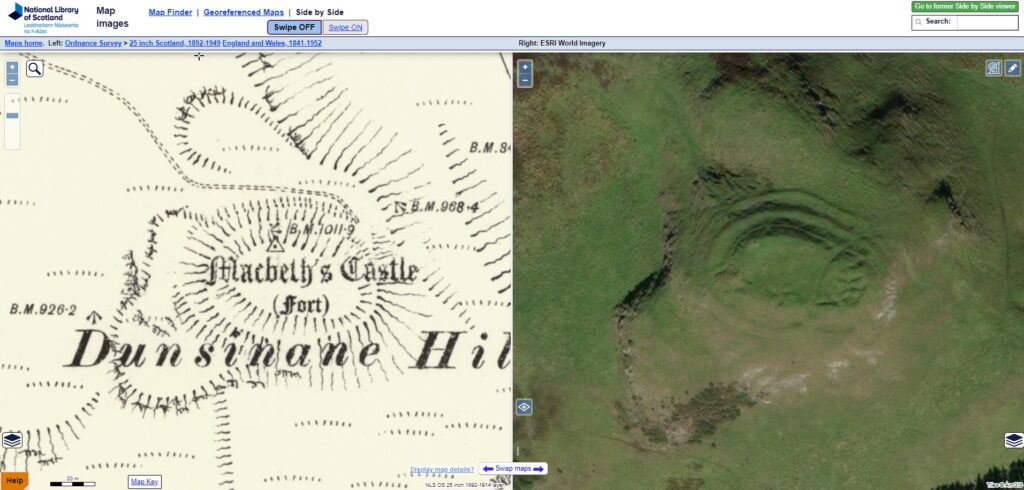
The HES Canmore database notes the excavation by Playfair in 1799, and one by Nairne in 1854. However, William Nairne, Lord Dunsinane, died in 1812, and so could not have carried out any excavation in 1854. He had been described by Sir Walter Scott as a man of great integrity, so clearly the two were on good terms. His successor was his nephew James Mellis – who adopted the name Nairne, and James’ heir when he died in 1866 was his brother John, and then a second William, not born until 1852. Therefore, any excavation carried out in 1854, or in “the previous year” must have been at the direction of James or John Mellis Nairne, and not a William Nairne.
This notwithstanding, the suggestion that a “true” Stone of Scone had been identified in excavation at Dunsinane in the period c1800-1820 has to be seen in the light of the heightened sense of national identity, the discovery of the Scottish regalia by Scott in 1818, and the substantial levels of interest and excitement in the rediscovery of Scottish heritage, and its being accepted once more into the mainstream of British “romantic” culture. Numerous accounts of Dunsinane were written for the sightseeing gentry describing MacBeth’s “castle” on the hill, recounting Shakespeare as if it was narrative history, sometimes alongside accounts of the excavation – although no mention of the Stone is made in these, only in the Chronicle letter.
The Stone of Scone, then, is almost certainly to my mind, a piece of Perthshire sandstone that had perhaps been relocated to Scone from another place nearby. It seems most likely to have been quarried and been used originally well before it came to Scone Monastery/Priory/Abbey. It is my personal opinion that the provenance of the stone is Roman, perhaps having been used in the fort at Inveralmond, or at the bridge across the Tay. Both lie immediately adjacent to Scone Park. Alternatively, a short distance upstream is the legionary fortress at Inchtuthil, the turf ramparts of which were faced with stone.
It seems possible that a Roman stone being used in the ceremonies associated with the making of a king of Scots – as opposed to a king of the Picts or the Gaels – appealed to a man called Constantine. In addition to Constantine the Great, the emperor of Rome who was made in Britain and who converted the Empire to Christianity, there are also echoes of namesake saints in his decision to abdicate and become a monk. Such medieval myth-making and appeals to the past were important when establishing realms, and the alliance between Constantine of Scotland and Bishop Cellach forged in 906. For the origins of such a stone to be forgotten in the 343 years that lay between that and the coronation of Alexander III is unsurprising. For it to be ignored by the early Stewart kings, with a strictly baronial background and determined to assert their credentials against the aggression of the later Plantagenet monarchs of England is equally unsurprising.
Symbols are important. But understanding why they are symbols is as well. Resurfacing as a symbol in the fervour of the “Scottish Revival” driven forward by Sir Walter Scott after centuries, the idea of a Stone withheld from the vengeful English king by a plucky underdog abbot has its appeals. But it is historically dubious. The Stone of Scone in Edinburgh Castle is, most likely, the same that sat under Alexander III in 1249 in his royal seat, and most likely many of his predecessors. But it is not Jacob’s Pillow, Columba’s portable altar, the Lia Fail, or the Stone of Destiny. Like the Holy Grail, the fabled artifact bearing those names lies closer to the grasp of Indiana Jones than to any of us.
The following images are taken from The History of Scottish Seals from the Eleventh to the Seventeenth Century (Walter de Gray Birch, 1905), digitised by Electric Scotland, which has many interesting books scanned in for public consumption that are out of copyright. Nice job, guys 🙂
I hope you enjoyed this blog. I would appreciate it if you could pop over to The Castle Guide to support my work with a monthly donation, and to access detailed histories of hundreds of castles. I dont have an emailing list so I wont be bothering you – but you will certainly be supporting me.
Keep safe, and Sláinte!
